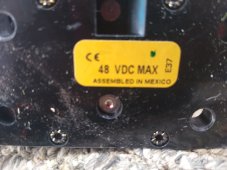So after last Winters debacle down here when the power was out for almost 3 days and the temp got down to 25 degrees about 10 miles from Mexico, I am looking into using the batteries in our golf cart as the battery pack for an inverter to power the refrigerator. The house fridge is 6.5a, but just got a mini fridge rated at 1.1a which might be a better option.
The cart is 48vdc (6 8vdc brand new deep cycle batteries) The batteries are rated at 150 (20hr) 120 (5hr). Thinking of purchasing a decent not too expensive inverter 2000-3000w.
First question: What input voltage inverter....48 or 24 vdc? I could reconnect the batteries to obtain 24 vdc, but would this get me more or less run time? I know the wiring would need to be larger to the inverter with 24vdc. I don't think you can run a 12vdc inverter from 16vdc battery pack and the wiring is again even larger?
Second question: considering some type of portable solar charging system. To charge a 48vdc battery pack I think I would need something like 5 or 6 panels. That's too many to set up temporarily and nowhere to store them. I think the 24vdc system would only need 2-3 panels maybe? Also the charge controller might be cheaper?
i know these subjects must have been discussed here before but I could not find what I was looking for. Thank you for taking the time to read this and possibly supplying more info.
The cart is 48vdc (6 8vdc brand new deep cycle batteries) The batteries are rated at 150 (20hr) 120 (5hr). Thinking of purchasing a decent not too expensive inverter 2000-3000w.
First question: What input voltage inverter....48 or 24 vdc? I could reconnect the batteries to obtain 24 vdc, but would this get me more or less run time? I know the wiring would need to be larger to the inverter with 24vdc. I don't think you can run a 12vdc inverter from 16vdc battery pack and the wiring is again even larger?
Second question: considering some type of portable solar charging system. To charge a 48vdc battery pack I think I would need something like 5 or 6 panels. That's too many to set up temporarily and nowhere to store them. I think the 24vdc system would only need 2-3 panels maybe? Also the charge controller might be cheaper?
i know these subjects must have been discussed here before but I could not find what I was looking for. Thank you for taking the time to read this and possibly supplying more info.




